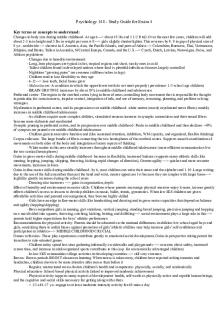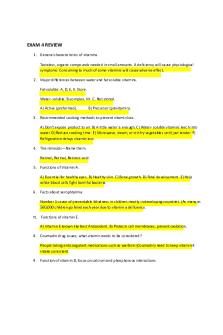Chapter 4 study guide - All that is on the exam PDF

| Title | Chapter 4 study guide - All that is on the exam |
|---|---|
| Course | Life in the Sea |
| Institution | Bowling Green State University |
| Pages | 2 |
| File Size | 63.1 KB |
| File Type | |
| Total Downloads | 69 |
| Total Views | 156 |
Summary
All that is on the exam...
Description
CHAPTER 4 Fundamentals of Biology Definitions – be able to define and recognize an example of the following: Carbohydrates
Osmoconformers
Proteins
Osmoregulators
Amino acids
ectotherms
Hormones
endotherms
Lipids
poikilotherms
Nucleic acids/DNA
homeotherms
Nucleotides
asexual reproduction
Photosynthesis
sexual reproduction
Autotrophs
Gametes
Heterotrophs
homeotherms
Cellular respiration
asexual reproduction
Primary production
sexual reproduction
Inorganic molecules
Gametes
Prokaryotic
Hermaphrodites
Eukaryotic
Natural selection/Evolution
Diffusion
Taxonomy
Osmosis
biological species concept phylogenetics
Comparison/Give examples Understand the levels of organization in the animal kingdom (atom through organism to ecosystem) How do organisms deal with salinity? How are osmoconformers different from osmoregulators? How are ectotherms different from endotherms? How are poikilotherms different from homeotherms? What combination would we consider “cold-blooded”? Warm-blooded? Name an exception to these groupings. Compare asexual to sexual reproduction. Compare broadcast spawning to internal fertilization. Under what conditions would broadcast spawning be best suited?
General concepts What makes a molecule organic, and what are the four main categories? What are the basic components of a eukaryotic cell? Understand why ice floats when it freezes. Why is this important biologically? What is meant when we say that water is the universal solvent? Under what conditions does salinity change? How are waves formed? How are high and low tides formed? How do spring and neap tides differ? How do tides affect marine organisms? Understand how natural selection works and leads to the evolution of new traits How does taxonomy provide us with information? What is the order of organization? Domain -> Kingdom -> etc…...
Similar Free PDFs

Exam 4 Study Guide
- 22 Pages

EXAM 4 study guide
- 15 Pages

Study Guide Exam 4
- 8 Pages

Exam 4 Study Guide
- 4 Pages

Study guide exam 4
- 6 Pages

Exam 4 Study Guide
- 5 Pages

Study guide chapter 4 exam 1
- 8 Pages

Chapter 4 Study Guide
- 4 Pages

Chapter 4 Study Guide
- 11 Pages

MGMT exam 4 - Study Guide exam 4
- 12 Pages

Chapter 4 Study Guide
- 9 Pages

Chapter-4 study guide
- 45 Pages

Chapter 4 Study Guide
- 9 Pages
Popular Institutions
- Tinajero National High School - Annex
- Politeknik Caltex Riau
- Yokohama City University
- SGT University
- University of Al-Qadisiyah
- Divine Word College of Vigan
- Techniek College Rotterdam
- Universidade de Santiago
- Universiti Teknologi MARA Cawangan Johor Kampus Pasir Gudang
- Poltekkes Kemenkes Yogyakarta
- Baguio City National High School
- Colegio san marcos
- preparatoria uno
- Centro de Bachillerato Tecnológico Industrial y de Servicios No. 107
- Dalian Maritime University
- Quang Trung Secondary School
- Colegio Tecnológico en Informática
- Corporación Regional de Educación Superior
- Grupo CEDVA
- Dar Al Uloom University
- Centro de Estudios Preuniversitarios de la Universidad Nacional de Ingeniería
- 上智大学
- Aakash International School, Nuna Majara
- San Felipe Neri Catholic School
- Kang Chiao International School - New Taipei City
- Misamis Occidental National High School
- Institución Educativa Escuela Normal Juan Ladrilleros
- Kolehiyo ng Pantukan
- Batanes State College
- Instituto Continental
- Sekolah Menengah Kejuruan Kesehatan Kaltara (Tarakan)
- Colegio de La Inmaculada Concepcion - Cebu


